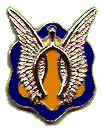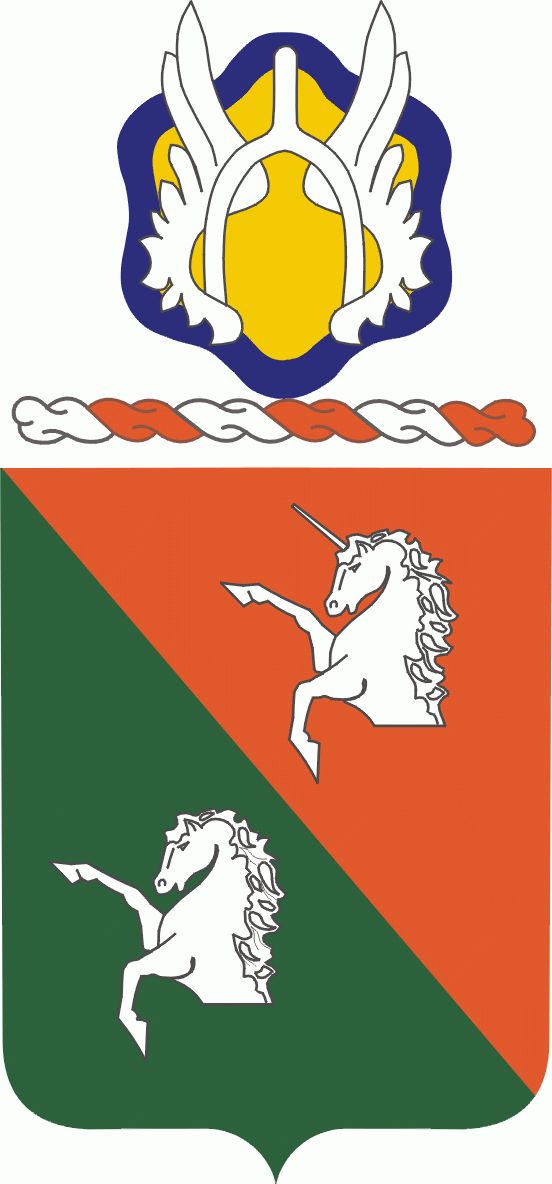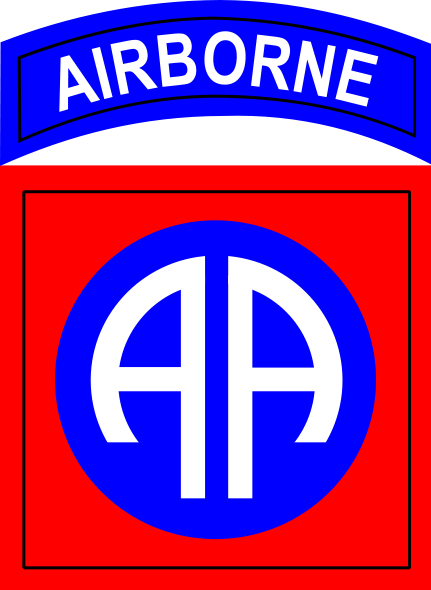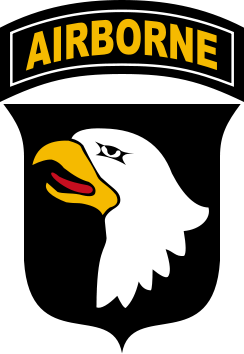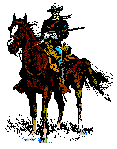In honor of the cavalry regiments that contributed officers, men and experience to the formation of the 17th Cavalry Regiment, the regimental shield shares much from the coats of arm of those units. Orange is from the lst Cavalry and was the official color that has historically represented dragoons. The color green was taken from the 3d Cavalry. Their uniforms contained green facings in honor of the 3d Cavalry's first engagement at Vera Cruz, and its contribution throughout the campaign of 1847 to the capture of Mexico City. The Regiment chose the unicorn from the 6th Cavalry Regiment, which represents the knightly virtues and, in the rampant position, a symbol of fighting aggressiveness, combined with speed and activity. The demihorse, in honor of cavalry mounts, was taken from the shield of the 8th Cavalry Regiment. The diagonal line, being the traditional military symbol of cavalry, came from the 14th Cavalry.[1]
The first mounted formation of the regiment was held on 4 August 1916 and consisted of all fifteen troops and the wagons of the supply Troop.
Arizona
14 May 1917, the Regiment received orders for a change of station due to disturbances along the border of Arizona. By 17 May, the Regiment loaded up on trains and travelled from El Paso to arrive at Douglas, Arizona, on the mid-afternoon of 18 May. The Regiment established itself at "Camp Harry J. Jones", Douglas, Arizona, with outposts near Naco, Arizona (30 miles west along the border), west of town near the C & A Copper Smelter, Forrest, Arizona, and Slaughter's Ranch (13 miles east).
Trouble began in the copper mining districts of Arizona as the Union (IWW) became unmanageable. On 5 July 1917 a provisional squadron, under the command of Lieutenant Colonel White, marched north to Globe, Arizona, for strike duty. Later that month, forest fires in Mormon Canyon (Turkey Creek) grew beyond the control of the forest rangers, prompting another call for assistance by the civil leaders; a detail of fifty men under 2nd Lieutenant Arthur S. Harrington was deployed to assist them. The Regiment would remain in the Southwest until the end of the war. After the armistice was signed, the Regiment was under orders to move to Hawaii.
Hawaii
On 5 April 1919, the 17th Cavalry set sail from San Francisco on the U.S.A.T. Sherman, bound for Honolulu and Schofield Barracks. The massive demobilization following the end of World War I, would leave the 17th Cavalry manning the garrison at Fort Shafter and Schofield Barracks until the fall of 1920. Still, the problem remained of covering approximately one hundred miles of rugged coast line with one regiment of cavalry to effectively repel any attempted landing of troops from transports and hold them off until the arrival of reinforcements. With the exception of the sector in and around the city of Honolulu and Pearl Harbor, the entire coast line of the island was left to the 17th Cavalry Regiment. The Regiment developed an intricate system of shielded lights and telephone lines for command and control as well as reporting, with camps placed in locations that provided excellent cover and concealment from the air or sea.
Reorganization in 1921 resulted in a reduction of the number of cavalry regiments from seventeen to fourteen, this included inactivation of the 17th Cavalry. Lack of funds, reduced personnel authorization, and serious doubts that "the mounted combat of large bodies of cavalry is probably a thing of the past" contributed to the decision as well as a new regimental organization that was designed to reduce overhead, increase firepower, and retain mobility. Many old, famous cavalry units came dangerously close to being lost to the Army because of organizational changes, but a new policy of retaining surplus units on the rolls of the Army in an inactive status was established, preserving unit designations and histories for future use rather than disbanding or redesignating them.
The regiment left Schofield Barracks by truck for Honolulu on September 16 and embarked on the U.S.A.T. Buford for Monterey, California. The officers and enlisted men were transferred to the 11th Cavalry on September 26, and the 17th Cavalry was placed on the inactive list.
